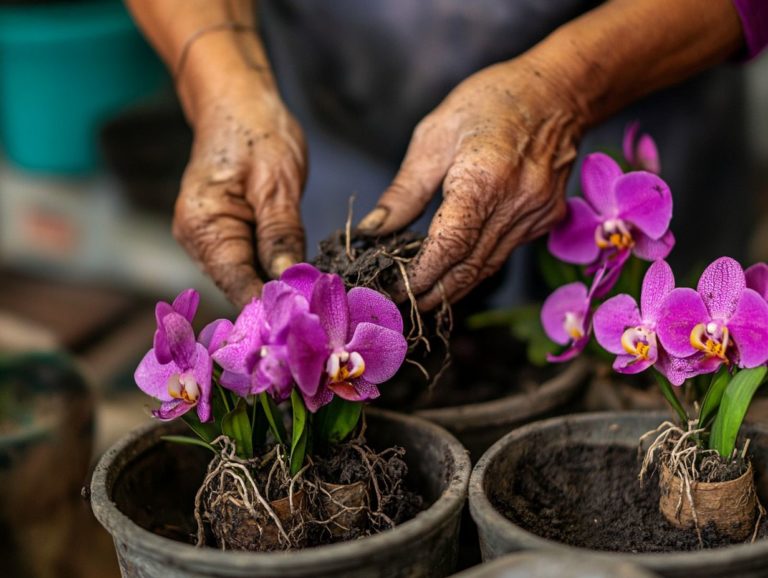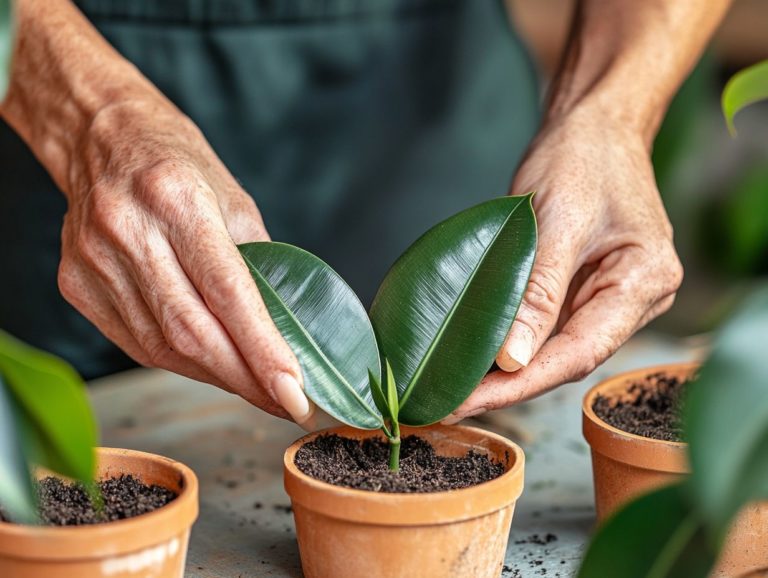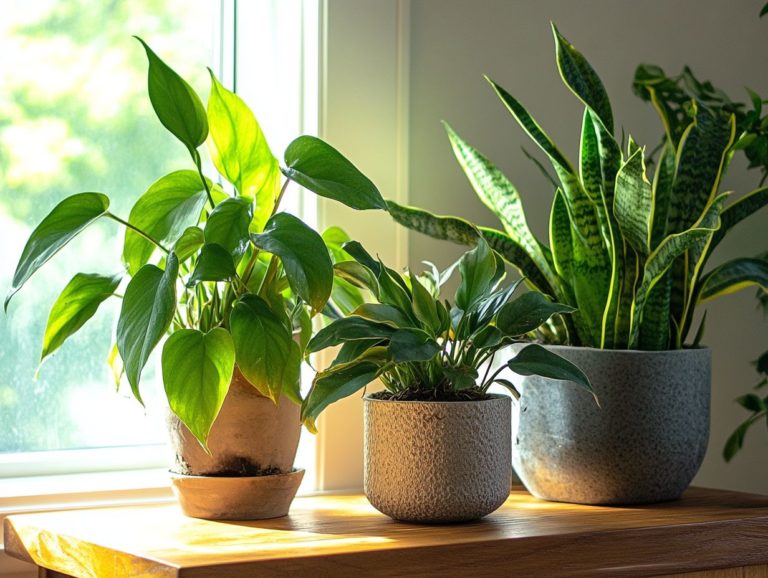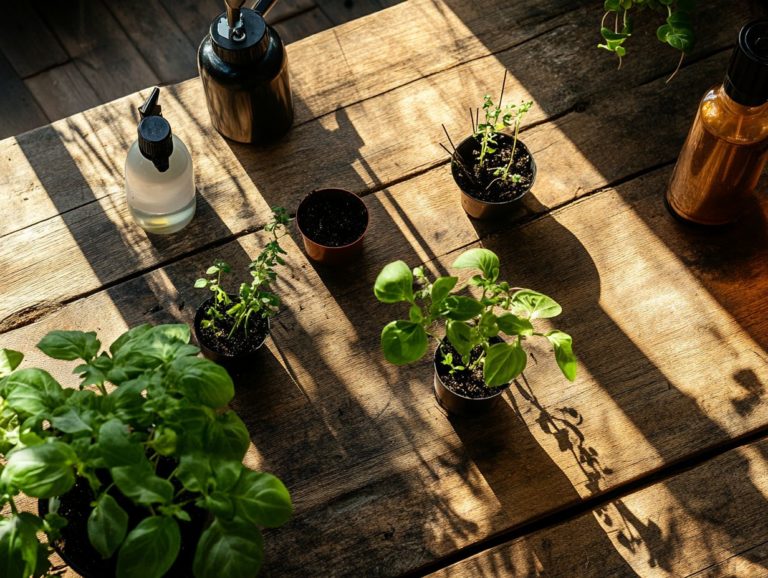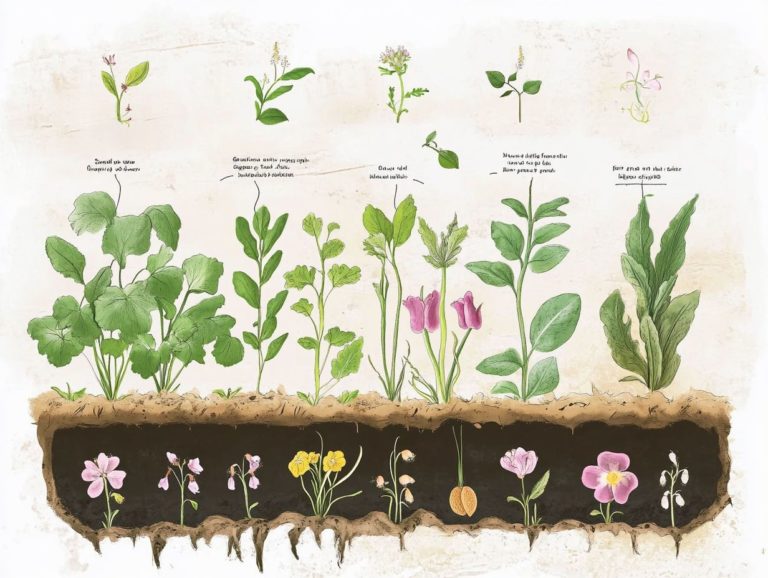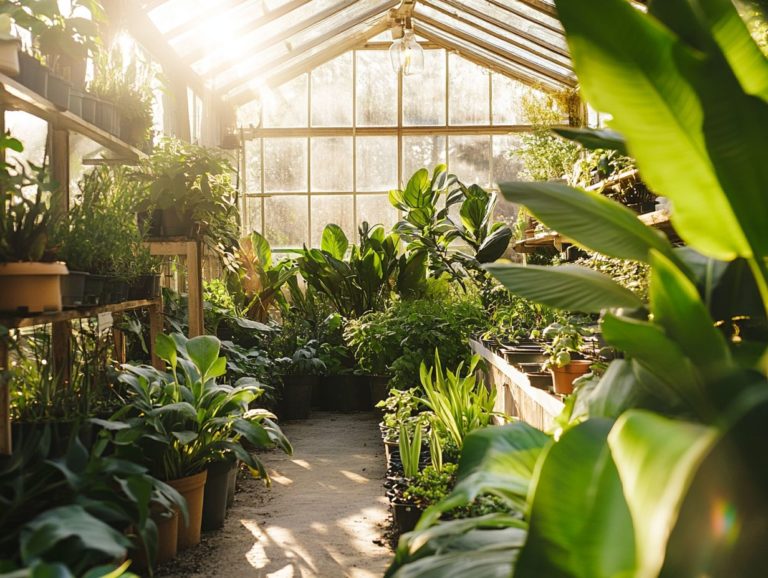Best Indoor Plant Varieties for Propagation
Indoor plants do more than just beautify your living space; they also provide a fulfilling hobby in the art of propagation. If you re eager to expand your collection or perhaps share some greenery with friends, certain varieties are exceptionally well-suited for this delightful process, including some easy propagation plants.
Discover the joy of propagation with these amazing plants! This article delves into the finest indoor plants for propagation, ranging from the resilient Spider Plant to the exotic allure of the Monstera. You ll also uncover essential propagation methods, optimal conditions, and care tips to ensure your new plants not only survive but truly thrive.
Contents
- Key Takeaways:
- 1. Spider Plant
- 2. Pothos
- 3. Snake Plant
- 4. Jade Plant
- 5. Aloe Vera
- 6. Chinese Evergreen
- 7. Rubber Plant
- 8. Philodendron
- 9. ZZ Plant
- 10. Monstera
- 11. Fiddle Leaf Fig
- 12. Prayer Plant
- 13. African Violet
- 14. Christmas Cactus
- 15. Succulents
- What Is Plant Propagation and Why Is It Beneficial?
- Frequently Asked Questions
- What are the best indoor plant varieties for propagation?
- What is propagation and why is it important for indoor plants?
- Can all indoor plants be propagated?
- What is the best method for propagating indoor plants?
- How long does it take for indoor plants to propagate?
- Are there any tips for successfully propagating indoor plants?
Key Takeaways:
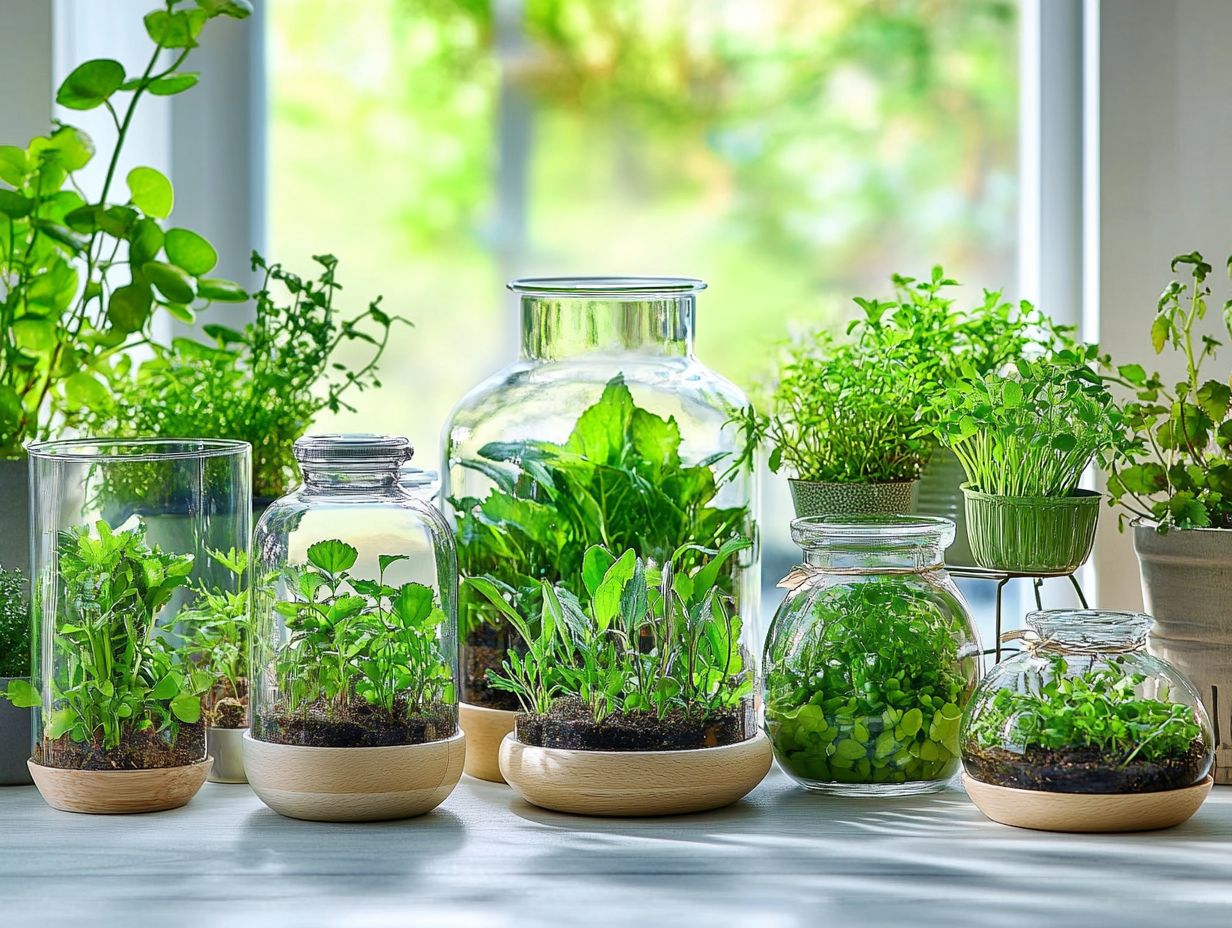
- Spider plants, pothos, and snake plants are easy to propagate and great for beginners.
- Aloe vera, Chinese evergreen, and rubber plants are perfect for propagation due to their resilience and ability to thrive in various conditions.
- Succulents, monstera, and fiddle leaf figs require more advanced techniques and specialized care for successful propagation.
1. Spider Plant
The Spider Plant, or Chlorophytum comosum, is a top pick for plant enthusiasts like you. Its eye-catching green and white striped leaves bring a lively touch to your indoor oasis while being refreshingly low-maintenance.
These delightful plants thrive in bright, indirect sunlight. They can adapt to lower light conditions, fitting seamlessly into various spaces in your home. To prevent root rot, which can be a common issue, allow the top inch of soil to dry out between watering. They thrive in moisture in the air, which is typically easy to achieve in most homes, especially during those balmy months.
Their ability to propagate quickly is another bonus, as they produce adorable baby plantlets that are perfect for replanting or sharing with friends. In the end, the Spider Plant not only elevates your indoor aesthetics with its lush foliage but also purifies the air, enhancing the overall vibe of your living space.
2. Pothos
Pothos, or Epipremnum aureum, is an indoor plant that you ll find hard to resist. It flourishes in a variety of conditions and is celebrated for its striking, heart-shaped leaves that can burst with vibrant colors. It s no wonder this beauty has become a staple in indoor gardens and a favorite among plant enthusiasts.
This versatile houseplant is a dream to propagate. Just take a healthy cutting with a few leaves and place it in water or soil, keeping the growing medium moist but not drenched. For the best results, position your Pothos in indirect sunlight and maintain a humid environment.
Don t forget to rotate the plant occasionally to ensure even growth. Its adaptability means it can thrive even in low light. Regularly dusting its leaves will enhance photosynthesis, leading to a lush and vibrant plant that truly stands out.
3. Snake Plant
The Snake Plant, or Sansevieria trifasciata, stands out as an exceptionally resilient indoor plant. With its upright, sword-like leaves and remarkable ability to thrive in low light and withstand irregular watering, it s no wonder this plant is a favorite among those looking for easy maintenance and healthy roots.
To help this striking species thrive, provide well-draining soil and allow the top inch of soil to dry out between waterings. The Snake Plant flourishes in indirect light and adapts beautifully to brighter settings, showcasing its impressive versatility.
If you’re interested in propagation, leaf cuttings offer a simple approach. Slice a leaf into sections and place them in soil; you ll soon be rewarded with new plants. This simplicity in propagation captivates both novice and seasoned gardeners alike.
Start your propagation journey today and enjoy a thriving indoor garden!
4. Jade Plant
The Jade Plant, scientifically known as Crassula ovata, is a cherished succulent with its thick, fleshy leaves that often symbolize prosperity and health. It’s no wonder it s a top pick for indoor gardening and an essential part of many plant collections.
Caring for this resilient plant means understanding its specific needs. Let the soil dry between waterings to prevent root rot, which helps maintain its vibrant foliage.
Jade Plants thrive in bright, indirect light, so placing them near windows is ideal just make sure to keep them out of direct sunlight to avoid leaf scorch.
For propagation, methods like leaf cuttings or stem cuttings are highly effective, especially when you utilize proper propagation methods. Just remember to let the cut ends callous over before planting. This little step promotes stronger root development, ensuring your new ‘plant babies’ grow healthy and robust, ready to flourish in your indoor garden and ultimately expand your plant collection. Don’t miss out on adding a Jade Plant to your home!
5. Aloe Vera
Aloe Vera is a stunning succulent celebrated for its medicinal properties and eye-catching presence, flourishing beautifully in sunny indoor settings. It’s no wonder plant enthusiasts like you are drawn to its charm, combining aesthetic appeal with health benefits.
To keep your Aloe Vera thriving, it s essential to provide well-draining soil consider using a cactus mix or a blend with sand and perlite to replicate its natural desert environment. In terms of watering, remember to be sparing; allow the top couple of inches of soil to dry out completely before you reach for that watering can.
Aloe Vera is also great for those interested in propagation. You can easily encourage new growth by cutting off healthy offsets, or pups , that emerge at the base. Let these cuttings dry for a day or two before planting them in fresh soil. This will ensure they take root effectively and add to your flourishing collection of succulents.
6. Chinese Evergreen
The Chinese Evergreen, or Aglaonema, is truly a gem in the world of houseplants, celebrated for its lush, colorful foliage and remarkable ability to grow well in low light and different humidity. This makes it an impeccable choice for your indoor spaces, especially if you’re a plant lover on the hunt for diverse varieties.
To keep your vibrant Chinese Evergreen flourishing, aim to maintain a warm environment, ideally between 65 F and 80 F, with moderate to high humidity levels. Consider misting the leaves regularly or using a pebble tray filled with water to give that humidity a little boost.
For propagation, you ll find that using stem cuttings is quite effective. Just cut a healthy stem below a node and place it in water or directly into quality potting mix until roots establish.
To keep your plant looking its best, regularly dust the leaves and avoid direct sunlight. This will help maintain those vivid colors and ensure your Chinese Evergreen remains healthy and beautiful for years to come.
7. Rubber Plant
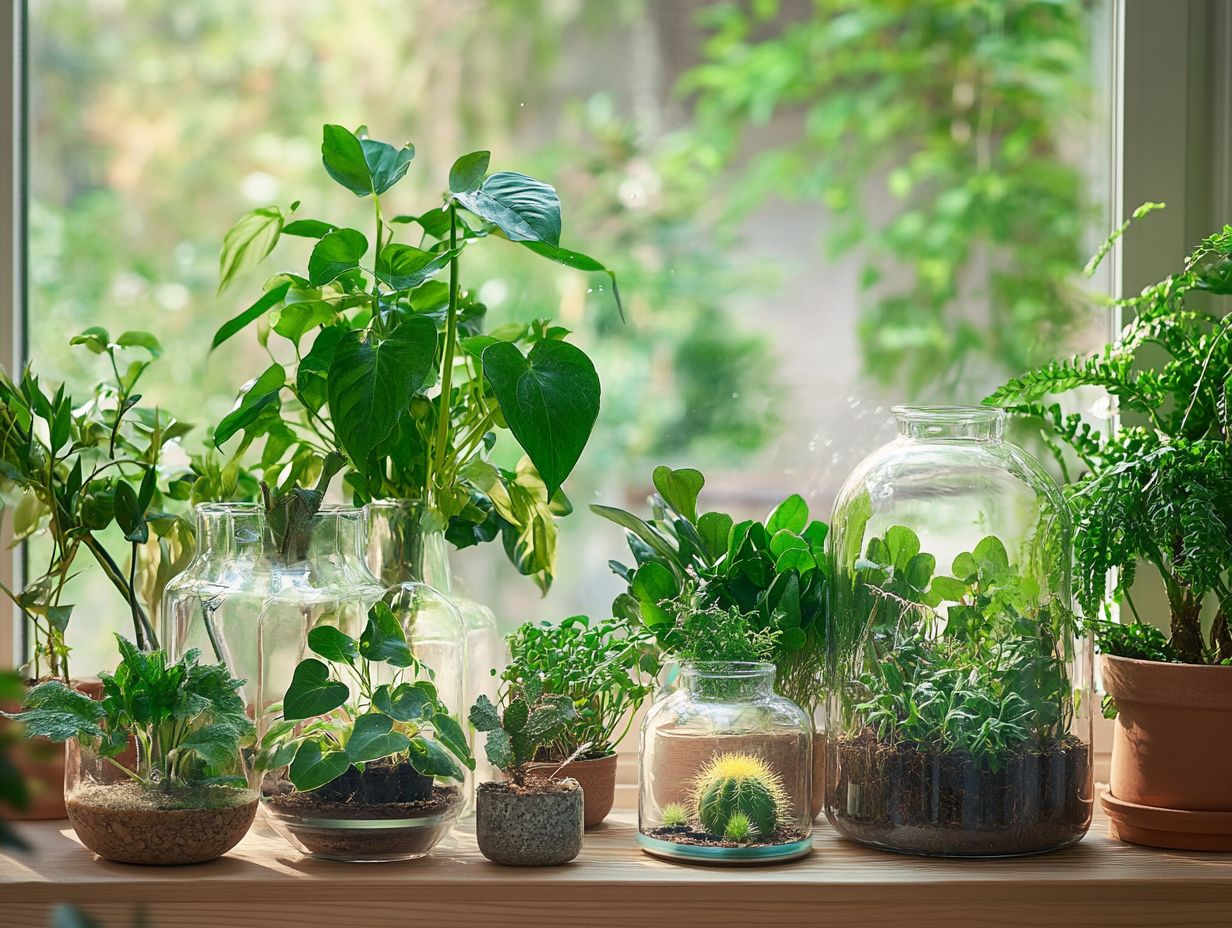
The Rubber Plant, or Ficus elastica, is a fantastic choice for your indoor space with its glossy, large leaves that effortlessly infuse a touch of the tropics into your home. If you’re looking to elevate your indoor jungle with vibrant color and minimal upkeep, this is a top contender.
For optimal growth, this plant flourishes in bright, indirect sunlight but can gracefully adapt to lower light conditions albeit with a slightly slower growth rate. Be mindful to allow the top inch of the soil to dry out between waterings; this small act can prevent the risk of overwatering and the root rot that often follows.
Propagation is a breeze. Just take a healthy stem cutting, let it callous for a day, and then place it in water or soil. It s that simple!
To keep your Rubber Plant thriving throughout its growth stages, a bit of occasional pruning and a gentle dusting of the leaves can go a long way in encouraging new growth and ensuring it always looks its best. Get started on your plant journey today!
8. Philodendron
Philodendron is a remarkable genus of indoor plants that you ll truly appreciate for their lush foliage and impressive adaptability to various light conditions. They ve become a staple in countless plant collections and a favorite among those looking to elevate their indoor gardening journey.
From the striking split leaves of the popular Philodendron Bipinnatifidum to the charming heart-leaf varieties like Philodendron Brasil, this genus offers something to suit every aesthetic preference.
To ensure optimal care, position your plants in medium to bright indirect light. Keep the soil moist, but never soggy. Regular pruning will not only encourage bushier growth but also eliminate any yellowing leaves, keeping your plants healthy and vibrant.
Propagation, or the process of growing new plants from cuttings or divisions, is a breeze with stem cuttings or division. This allows you to easily expand your collection. To learn more about the best practices, check out effective propagation techniques for indoor plants. With the right attention to humidity levels and occasional fertilization, these incredible plants can thrive beautifully in nearly any indoor environment.
9. ZZ Plant
The ZZ Plant, scientifically known as *Zamioculcas zamiifolia*, is celebrated for its strikingly glossy leaves and remarkable ability to thrive in low-light conditions. It s no wonder this beauty has captured the hearts of plant lovers who value both its aesthetic appeal and resilience in indoor settings.
Caring for this resilient plant involves meeting specific needs, especially regarding soil moisture and watering practices. Opt for a well-draining potting mix that allows excess water to escape easily. Avoid letting the roots sit in water as this can lead to rot a condition caused by excess water.
A thorough watering schedule is essential. Water promptly when the soil dries out completely between watering sessions. If you’re interested in plant propagation, consider dividing the rhizomes or using leaf cuttings; both methods can yield new plants that retain the same robust traits.
With its forgiving nature, the ZZ Plant continues to gain popularity among indoor plant enthusiasts, providing a stunning yet low-maintenance addition to their indoor jungle.
10. Monstera
Monstera, or *Monstera deliciosa*, is the tropical gem you’ve been searching for, renowned for its striking, split-leaf appearance. It s the perfect centerpiece for your indoor plant collection and a must-have for anyone looking to cultivate their own indoor jungle!
This leafy wonder seeks a humid environment, ideally basking in 60-80% humidity. It craves bright, indirect light direct sunlight? That s a surefire way to scorch those gorgeous leaves. Position it near a window adorned with sheer curtains for the ideal setup.
Propagation is simple; take stem cuttings that include a node and place them in water until roots form. This easy method yields satisfying results. However, avoid common pitfalls by learning about the top 7 mistakes in indoor plant propagation. Once your new growth appears, ensure those fresh cuttings receive ample light and moisture, both of which are essential for helping them adapt and flourish.
11. Fiddle Leaf Fig
The Fiddle Leaf Fig, or *Ficus lyrata*, stands as an iconic indoor plant, celebrated for its large, dramatic leaves and impressive height. It becomes a statement piece in any room; however, it demands thoughtful care to thrive and maintain its vibrant color.
To keep this popular houseplant flourishing, provide it with bright, indirect light. Direct sunlight can scorch its lush leaves, which we certainly want to avoid. Water when the top inch of soil feels dry, typically every one to two weeks. Ensure proper drainage to prevent root rot no one wants a soggy situation!
Regularly dusting its leaves will help maintain their health and optimize photosynthesis. If you re interested in propagation, you can take stem cuttings and place them in water or soil, ensuring they receive consistent moisture throughout the rooting process.
By following these care guidelines, you can enjoy the striking beauty of the Fiddle Leaf Fig for many years to come!
Start your indoor garden adventure today with these stunning plants!
12. Prayer Plant
The Prayer Plant, or Maranta leuconeura, is a truly enchanting indoor plant, celebrated for its exquisite foliage and its delightful habit of folding its leaves at night. This charming characteristic makes it a wonderful addition to your home. However, it requires certain humidity levels and specific care to thrive.
To keep this stunning plant in peak condition, aim to maintain a humidity level of around 50-70%. Regularly misting the leaves or utilizing a pebble tray can help you achieve this effortlessly. In terms of watering, ensure the soil remains consistently moist but never soggy. Checking every few days will be crucial. Proper drainage is essential to prevent root rot and keep your Prayer Plant happy.
To preserve the vivid colors of its leaves, provide bright, indirect light while avoiding direct sunlight. If you’re considering propagation, simply take a stem cutting with a few leaves. It should root beautifully in either water or soil that holds moisture well. For the best results, check out the best indoor plants for propagation and get ready to expand your plant family with this easy propagation method!
13. African Violet
African Violets, or Saintpaulia, are indoor plants that you ll cherish for their stunning blooms and delightful, fuzzy leaves. Plant lovers absolutely adore these vibrant beauties, reveling in vibrant colors and the joy of nurturing new plant babies.
To help these captivating plants thrive, it is essential to pay attention to their unique care requirements. They flourish in bright, indirect light but can adapt to lower lighting conditions, though this can affect how many flowers they produce. Establishing a consistent watering routine is vital; allow the top inch of soil to dry out before re-watering to prevent root rot.
If you’re looking to expand your collection, propagation is simple with leaf cuttings. Snip a healthy leaf, and place it in water or soil to begin the process. For a unique approach, consider propagating indoor plants without soil and watch as new plants sprout, turning your space into a lush oasis.
14. Christmas Cactus
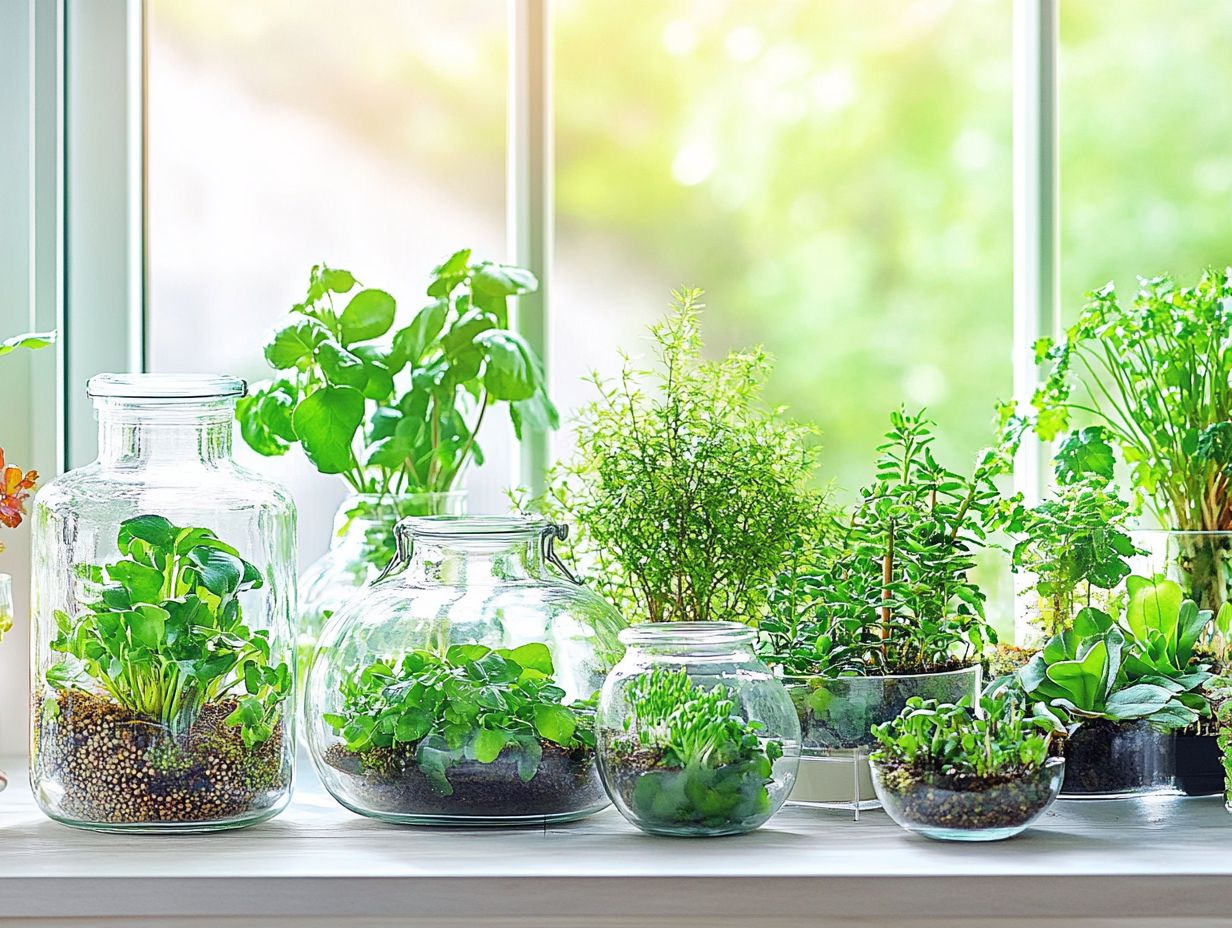
The Christmas Cactus, or Schlumbergera, stands out as a remarkable indoor plant that blooms during the holiday season. It infuses your home with vibrant colors and a festive ambiance. To truly appreciate its beauty, you need to give it the care it deserves to ensure its health and longevity.
Provide this plant with bright, indirect light. Water it only when the top inch of soil feels dry to avoid root rot. During its active growth phase in spring and summer, feed it regularly with a balanced fertilizer every few weeks to promote robust growth.
If you re looking to multiply your Christmas Cactus, it s quite simple: just take stem cuttings and allow them to callus before planting in well-draining soil. Keeping a consistent temperature and humidity level will greatly boost its blooming potential, ensuring you re treated to a stunning display of flowers during the festive season.
15. Succulents
Succulents are remarkably versatile and immensely popular houseplants, celebrated for their unique shapes and water-storing abilities. They re the perfect choice whether you re just starting out or you re a seasoned plant enthusiast who enjoys easy propagation and the simple pleasure of nurturing them.
These delightful plants come in an array of shapes and colors, from the elegant rosette formation of Echeveria to the striking tubular allure of Aeonium. They flourish in bright, indirect light, but each variety can have its own specific needs, such as well-draining soil and tailored watering based on their individual characteristics.
By grasping these nuances, you can cultivate a thriving collection that enhances any indoor space. With minimal upkeep, succulents shine as low-maintenance companions, offering a refreshing touch of greenery without overwhelming responsibility.
Whether you re propagating through leaves or offsets, the joy of nurturing these plants transcends their visual appeal, adding a deeper layer of satisfaction to your green journey.
What Is Plant Propagation and Why Is It Beneficial?
Plant propagation is your gateway to creating new plants from existing ones, enriching your collection while promoting healthy growth. It s a rewarding endeavor for anyone looking to elevate their indoor gardening experience and deepen their understanding of plant care. Get ready to transform your indoor space into a lush paradise!
You have a variety of propagation techniques at your disposal, with cutting methods standing out for their simplicity and effectiveness. Techniques like stem cuttings enable you to easily replicate your favorite plants, fostering a deeper bond with your greenery. By employing methods such as leaf cuttings or division, you can diversify your plant varieties. It’s also essential to know the best time to propagate your indoor plants, transforming your garden into a vibrant and ecologically rich sanctuary.
This practice not only nurtures a sustainable gardening ethos reducing the need to purchase new plants from commercial sources but also plays a crucial role in preserving plant genetic diversity, which is essential for a resilient ecosystem.
What Are the Different Methods of Plant Propagation?
You have several propagation methods available to create new plants, including cutting techniques like leaf cuttings and stem cuttings. Each method comes with its own set of advantages and challenges, making your journey in plant propagation both exciting and nuanced.
By understanding these techniques, you can select the one that best fits your specific plant varieties. After all, the right approach can dramatically improve survival rates and growth potential.
For example, stem cuttings are generally preferred for woody plants, while leaf cuttings may work wonders for succulents. Environmental factors like humidity and light exposure are key to successful propagation, so careful monitoring and adjustments are essential.
As you dive into these various methods, remember that patience and practice will yield rewarding results, allowing you to cultivate a deeper connection with your vibrant greenery.
What Are the Best Conditions for Propagating Indoor Plants?
Creating the perfect conditions for your indoor plants is essential for success. Factors such as humidity levels, soil moisture, and proper lighting can dramatically influence the growth rate and overall health of your plants.
To achieve those optimal conditions, aim to maintain humidity levels between 50% and 70%. You can easily accomplish this with a humidifier, a plant care guide, or by placing a tray of water nearby to enhance the atmosphere.
Monitoring soil moisture is just as crucial; keep the medium consistently moist but not waterlogged. A moisture meter can be your best friend here, accurately gauging the soil’s hydration status for optimal plant growth.
Position your plants in bright, indirect light to encourage robust growth while avoiding the risk of scorching. Regularly checking the environment allows you to address any fluctuations promptly, ensuring a thriving indoor plant propagation process.
How Can One Care for Newly Propagated Plants?
Caring for your newly propagated plants is crucial for their survival and thriving. This requires your attention to factors like watering frequency and the right plant nursery techniques, as well as nutrient needs during those early growth stages to promote healthy plants.
Finding the perfect balance in these areas is key. Overwatering might invite root rot, while underwatering could stunt their growth and hinder new plant growth. As a new plant owner, consider the significance of light exposure. Different species have unique requirements some flourish in bright, indirect light, while others thrive in partial shade.
Selecting the right soil mix is also essential for maintaining proper soil moisture, as it impacts drainage and the nutrients plants need. Choose a soil mix that suits your plants well.
Ultimately, patience and keen observation will serve you well in noticing subtle changes, allowing you to make timely adjustments in care that will help your indoor garden flourish.
What Are Some Common Mistakes to Avoid When Propagating Indoor Plants?
When propagating indoor plants, it is easy to fall into common traps that can hinder your success. Overwatering, improper lighting, and neglecting the right methods for each type of plant can all negatively affect the health of your new green friends.
To achieve outstanding results, be mindful of these pitfalls and take proactive steps to avoid them. Overwatering can quickly cause root rot, so check soil moisture levels before reaching for the watering can. Allowing cuttings to dry out slightly between waterings encourages strong root development.
It is equally important to provide adequate, indirect sunlight for your cuttings. Too much direct sunlight can scorch their delicate leaves, especially for tropical plants. Remember, different plants require different propagation techniques whether it involves stem cuttings, leaf cuttings, or how to propagate herbs indoors by dividing roots.
By understanding the unique needs of each plant, you can dramatically increase your chances of successful propagation. This will result in robust, healthy specimens that thrive beautifully in your space, enriching your growing plant collection.
Frequently Asked Questions
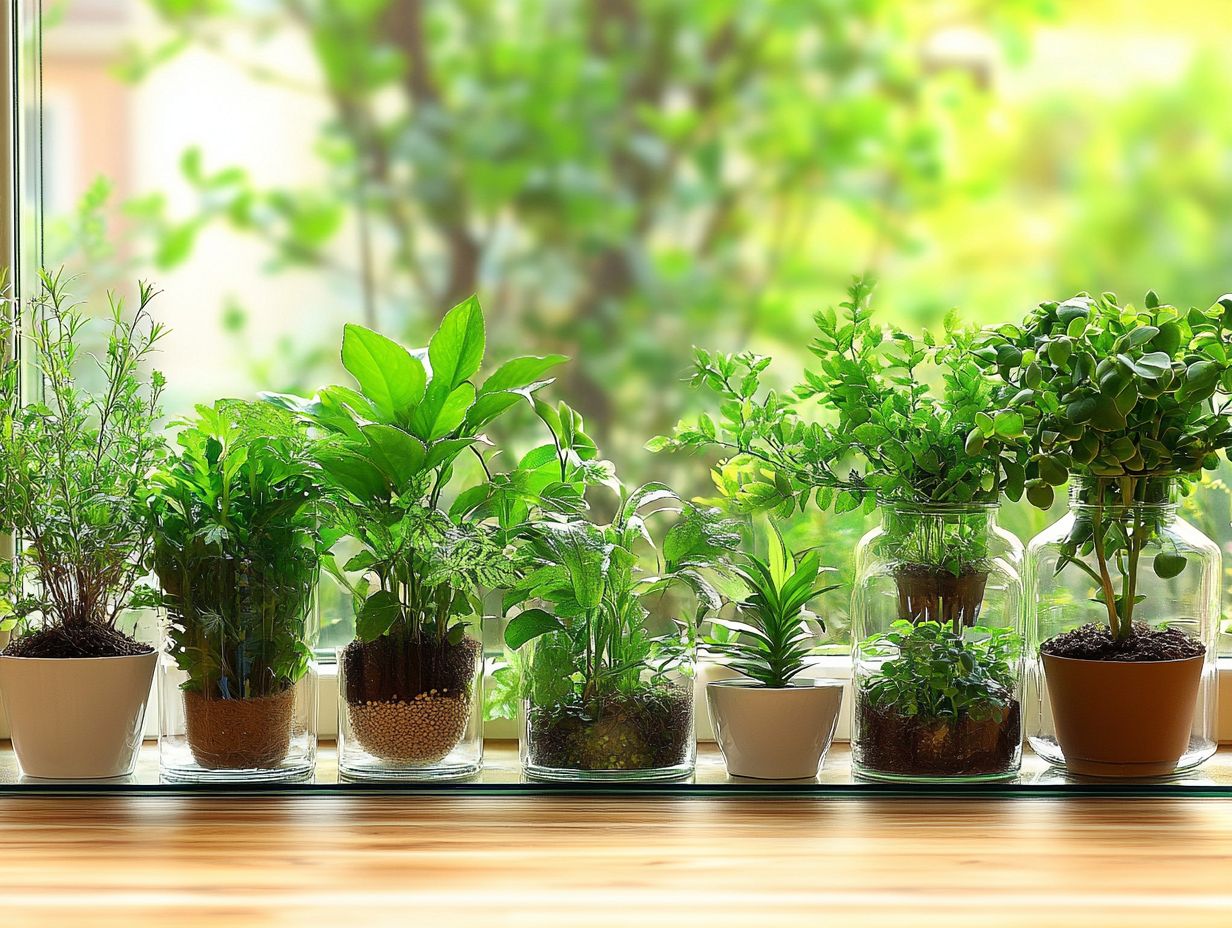
What are the best indoor plant varieties for propagation?
- Pothos
- Snake plant
- Spider plant
- Philodendron
What is propagation and why is it important for indoor plants?
Propagation is the process of creating new plants from existing ones. It is important because it allows you to expand your plant collection without purchasing new plants, helps keep your existing plants healthy, and can save money.
Can all indoor plants be propagated?
No, not all indoor plants can be propagated. Some plants, such as succulents and cacti, are easier to propagate than others, like Christmas cactus, and have a higher success rate.
What is the best method for propagating indoor plants?
The best methods for propagating indoor plants include stem cuttings, leaf cuttings, division, or layering. It is essential to research the specific method that works best for the plant variety you are trying to propagate.
How long does it take for indoor plants to propagate?
The time it takes for indoor plants to propagate can vary depending on the plant variety and method used. Generally, it can take anywhere from a few weeks to a few months for roots to develop and new growth to appear.
Are there any tips for successfully propagating indoor plants?
Yes, some tips for successful propagation include using clean, sharp tools, choosing healthy parent plants from a reputable plant nursery, providing the right environment and care for the new cuttings, and being patient, as the process can take time.

